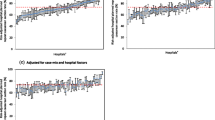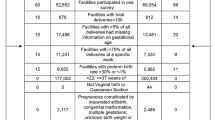Abstract
Non-medically indicated (NMI) deliveries prior to 39 weeks increase the risk of neonatal mortality, excess morbidity, and health care costs. The study’s purpose was to identify maternal and hospital characteristics associated with NMI deliveries prior to 39 weeks. The study included 207,775 births to women without a previous cesarean and 38,316 births to women with a previous cesarean, using data from Florida’s 2006–2007 linked birth certificate and inpatient record file. Adjusted risk ratios (ARR) and 95 % confidence intervals (CI) for characteristics were calculated using generalized estimating equation for multinomial logistic regression. Among women without a previous cesarean, NMI deliveries occurred in 18,368 births (8.8 %). Non-medically indicated inductions were more likely in women who were non-Hispanic white (ARR: 1.41, 95 % CI 1.31–1.52), privately-insured (ARR: 1.42, 95 % CI 1.26–1.59), and delivered in hospitals with <500 births per year. Non-medically indicated primary cesareans were more likely in women who were older than 35 years (ARR: 2.96, 95 % CI 2.51–3.50), non-Hispanic white (ARR: 1.44, 95 % CI 1.30–1.59), and privately-insured (ARR: 1.43, 95 % CI 1.17–1.73). Non-medically indicated primary cesareans were also more likely to occur in hospitals with <30 % nurse-midwife births, <500 births per year, and in large metro areas. Among women with previous cesarean, NMI repeat cesareans occurred in 16,746 births (43.7 %). Only weak risk factors were identified for NMI repeat cesareans. The risk factors identified varied by NMI outcome. This information can be used to inform educational campaigns and identify hospitals that may benefit from quality improvement efforts.



Similar content being viewed by others
References
Cheng, Y. W., Nicholson, J. M., Nakagawa, S., et al. (2008). Perinatal outcomes in low-risk term pregnancies: Do they differ by week of gestation? American Journal of Obstetrics and Gynecology, 199(4), 370e1–370e7. doi:10.1016/j.ajog.2008.08.008.
Shapiro-Mendoza, C. K., Tomashek, K. M., Kotelchuck, M., et al. (2008). Effect of late-preterm birth and maternal medical conditions on newborn morbidity risk. Pediatrics, 121(2), e223–e232. doi:10.1542/peds.2006-3629.
Reddy, U. M., Ko, C. W., Raju, T. N., et al. (2009). Delivery indications at late-preterm gestations and infant mortality rates in the United States. Pediatrics, 124(1), 234–240. doi:10.1542/peds.2008-3232.
Madar, J., Richmond, S., & Hey, E. (1999). Surfactant-deficient respiratory distress after elective delivery at ‘term’. Acta Paediatrica, 88(11), 1244–1248.
Hansen, A. K., Wisborg, K., Uldbjerg, N., et al. (2007). Elective caesarean section and respiratory morbidity in the term and near-term neonate. Acta Obstetricia et Gynecologica Scandinavica, 86(4), 389–394. doi:10.1080/00016340601159256.
Wilmink, F. A., Hukkelhoven, C. W., Lunshof, S., et al. (2010). Neonatal outcome following elective cesarean section beyond 37 weeks of gestation: A 7-year retrospective analysis of a national registry. American Journal of Obstetrics and Gynecology, 202(3), 250–258. doi:10.1016/j.ajog.2010.01.052.
Tita, A. T., Landon, M. B., Spong, C. Y., et al. (2009). Timing of elective repeat cesarean delivery at term and neonatal outcomes. The New England Journal of Medicine, 360(2), 111–120. doi:10.1056/NEJMoa0803267.
Clark, S. L., Miller, D. D., Belfort, M. A., et al. (2009). Neonatal and maternal outcomes associated with elective term delivery. American Journal of Obstetrics and Gynecology, 200(2), 156e1–156e4. doi:10.1016/j.ajog.2008.08.068.
Hoffmire, C. A., Chess, P. R., Ben Saad, T., et al. (2012). Elective delivery before 39 weeks: The risk of infant admission to the neonatal intensive care unit. Maternal and Child Health Journal, 16(5), 1053–1062. doi:10.1007/s10995-011-0830-9.
Dietz, P. M., Rizzo, J. H., England, L. J., et al. (2012). Early term delivery and health care utilization in the first year of life. The Journal of Pediatrics, 161(2), 234–239. doi:10.1016/j.jpeds.2012.02.005.
Ghartey, K., Coletta, J., Lizarraga, L., et al. (2012). Neonatal respiratory morbidity in the early term delivery. American Journal of Obstetrics and Gynecology, 207(4), 292e1–292e4. doi:10.1016/j.ajog.2012.07.022.
Hibbard, J. U., Wilkins, I., Sun, L., et al. (2010). Respiratory morbidity in late preterm births. JAMA, The Journal of the American Medical Association, 304(4), 419–425. doi:10.1001/jama.2010.1015.
ACOG Practice Bulletin No. 107. (2009). Induction of labor. Obstetrics and Gynecology, 114(2 Pt 1), 386–397. doi:10.1097/AOG.0b013e3181b48ef5.
ACOG Practice Bulletin No. 97. (2008). Fetal lung maturity. Obstetrics and Gynecology, 112(3), 717–726. doi:10.1097/AOG.0b013e318188d1c2.
ACOG Committee Opinion No. 561. (2013). Nonmedically indicated early-term deliveries. Obstetrics and Gynecology, 121(4), 911–915.
Davidoff, M. J., Dias, T., Damus, K., et al. (2006). Changes in the gestational age distribution among U.S. singleton births: Impact on rates of late preterm birth, 1992–2002. Seminars in Perinatology, 30(1), 8–15. doi:10.1053/j.semperi.2006.01.009.
Martin, J. A., Hamilton, B. E., Ventura, S. J., et al. (2011). Births: Final data for 2009. National vital statistics reports: From the Centers for Disease Control and Prevention, National Center for Health Statistics, National Vital Statistics System, 60(1), 1–70.
Zhang, J., Troendle, J., Reddy, U. M., et al. (2010). Contemporary cesarean delivery practice in the United States. American Journal of Obstetrics and Gynecology, 203(4), 326e1–326e10. doi:10.1016/j.ajog.2010.06.058.
Donovan, E. F., Lannon, C., Bailit, J., et al. (2010). A statewide initiative to reduce inappropriate scheduled births at 36(0/7)-38(6/7) weeks’ gestation. American Journal of Obstetrics and Gynecology, 202(3), 243e1–243e8. doi:10.1016/j.ajog.2010.01.044.
Oshiro, B. T., Henry, E., Wilson, J., et al. (2009). Decreasing elective deliveries before 39 weeks of gestation in an integrated health care system. Obstetrics and Gynecology, 113(4), 804–811. doi:10.1097/AOG.0b013e31819b5c8c.
Clark, S. L., Frye, D. R., Meyers, J. A., et al. (2010). Reduction in elective delivery at <39 weeks of gestation: Comparative effectiveness of 3 approaches to change and the impact on neonatal intensive care admission and stillbirth. American Journal of Obstetrics and Gynecology, 203(5), 449e1–449e6. doi:10.1016/j.ajog.2010.05.036.
Fisch, J. M., English, D., Pedaline, S., et al. (2009). Labor induction process improvement: A patient quality-of-care initiative. Obstetrics and Gynecology, 113(4), 797–803. doi:10.1097/AOG.0b013e31819c9e3d.
Clayton, H. B., Sappenfield, W. M., Gulitz, E., et al. (2012). The Florida investigation of primary late preterm and cesarean delivery: The accuracy of the birth certificate and hospital discharge records. Maternal and Child Health Journal,. doi:10.1007/s10995-012-1065-0.
Lydon-Rochelle, M. T., Holt, V. L., Cardenas, V., et al. (2005). The reporting of pre-existing maternal medical conditions and complications of pregnancy on birth certificates and in hospital discharge data. American Journal of Obstetrics and Gynecology, 193(1), 125–134. doi:10.1016/j.ajog.2005.02.096.
Kahn, E. B., Berg, C. J., & Callaghan, W. M. (2009). Cesarean delivery among women with low-risk pregnancies: A comparison of birth certificates and hospital discharge data. Obstetrics and Gynecology, 113(1), 33–40. doi:10.1097/AOG.0b013e318190bb33.
MacIntyre, C. R., Ackland, M. J., Chandraraj, E. J., et al. (1997). Accuracy of ICD-9-CM codes in hospital morbidity data, Victoria: Implications for public health research. Australian and New Zealand Journal of Public Health, 21(5), 477–482.
The Joint Commission (2011). Specifications manual for joint commission national quality core measures (2011a). https://manual.jointcommission.org/releases/TJC2011A/AppendixATJC.html#Table_Number_11_07_Conditions_Po. Accessed October 2011.
The Leapfrog Group (2010). Leapfrog hospital survey reference book. https://www.leapfroghospitalsurvey.org/survey_downloads/reference.pdf. Accessed September 24 2010.
ACOG Committee Opinion No. 560. (2013). Medically indicated late-preterm and early-term deliveries. Obstetrics and Gynecology, 121(4), 908–910.
Ingram, D. D., & Franco, S. J. (2012). NCHS urban-rural classification scheme for counties. Vital and health statistics. Series 2. Data evaluation and methods research, 154, 1–65.
Accreditation Council for Graduate Medical Education. Reports—programs by specialties: Obstetrics and gynecology. http://www.acgme.org/adspublic/default.asp. Accessed November 18 2011.
Behrman, R. E., & Butler, A. S. (Eds.). (2007). Preterm birth: Causes, consequences, and prevention. Washington DC: National Academy of Sciences.
Monari, F., Di Mario, S., Facchinetti, F., et al. (2008). Obstetricians’ and midwives’ attitudes toward cesarean section. Birth, 35(2), 129–135. doi:10.1111/j.1523-536X.2008.00226.x.
Josefsson, A., Gunnervik, C., Sydsjo, A., et al. (2011). A comparison between Swedish midwives’ and obstetricians’ and gynecologists’ opinions on cesarean section. Maternal and Child Health Journal, 15(5), 555–560. doi:10.1007/s10995-010-0630-7.
Main, E., Oshiro, B., Chagolla, B., et al. (2010) Elimination of non-medically indicated (Elective) deliveries before 39 weeks gestational age. (California maternal quality care collaborative toolkit to transform maternity care) Developed under contract #08-85012 with the California Department of Public Health; Maternal, Child and Adolescent Health Division. July 2010 (ed) March of Dimes.
Acknowledgments
We thank Donald Dudley, MD (University of Texas Health Science Center at San Antonio) and Scott Berns, MD, MPH (March of Dimes) for their helpful comments. None of the persons acknowledged received any compensation.
Author information
Authors and Affiliations
Corresponding author
Rights and permissions
About this article
Cite this article
Womack, L.S., Sappenfield, W.M., Clark, C.L. et al. Maternal and Hospital Characteristics of Non-Medically Indicated Deliveries Prior to 39 Weeks. Matern Child Health J 18, 1893–1904 (2014). https://doi.org/10.1007/s10995-014-1433-z
Published:
Issue Date:
DOI: https://doi.org/10.1007/s10995-014-1433-z




